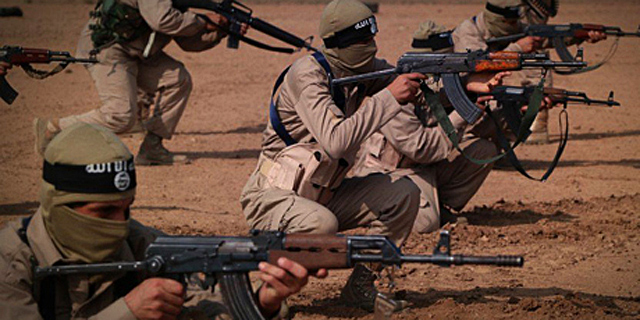

| Online: | |
| Visits: | |
| Stories: |
Islamic Terror Threat Biggest in History
US INTEL CHIEF: ISLAMIC TERROR THREAT BIGGEST IN HISTORY
Thu, February 11, 2016
Director of National Intelligence James Clapper said February 9 the Sunni terrorist threat “has been on an upward trajectory since the late 1970s and has more groups, members and safe havens that at any other point in history.”
Defense Intelligence Agency Director Lt. Gen. Vincent R. Stewart also testified and his assessment wasn’t rosier.
More than 36,500 foreign fighters have gone to Syria, including at least 6,000 from Western countries, since 2012, said Stewart.
Within the U.S., the FBI arrested some five dozen Islamic State (ISIS/ISIL) supporters last year, a 500% increase from 2014.
“ISIL will likely increase the pace and lethality of its transnational attacks as infrastructure and capabilities mature. It will purposely attempt to stroke sectarian conflict between Shia and and between the West and Islam to create the chaotic environment in which it thrives,” Stewart said.
Watch the Clarion Project on Newsmax TV’s “Newsmax Prime with J.D. Hayworth” discussing this topic:
The Islamic State will hold onto Mosul in Iraq through at least the end of the year, Stewart believes. It is the centerpiece of thein Iraq and has enormous ideological value to the group.
The reason is that the Iraqi Security Forces, Kurdish Peshmerga and the Shiite and Sunni elements of the Popular Mobilization Forces (a coalition of militias, many of which are linked to Iran) lack the logistics, morale, qualified soldiers and overall military preparedness.
Stewart said the program to enlist Sunnis in the fight against ISIS—which proved decisive in beating back Al-Qaeda previously—is failing because of concerns about Iranian influence, persecution by Shiite militias and a lack of funding and material.
The latter two elements validate Sunni complaints that the U.S. is inadequately supporting them due to the Iraqi central government’s insistence that all U.S. assistance be routed through Baghdad.
Clapper’s statement that Sunni terrorism has been on an “upward trajectory” casts a shadow over the Obama Administration’s boast that ISIS has lost 40% of its caliphate in Iraq and 20% of it in Syria.
It is true ISIS has lost ground and the statistic may be accurate, but Clapper’s statement shows it does not tell the whole story.
The testimonies of Clapper and Stewart explain that ISIS is expanding outside of Iraq and Syria, especially in Libya.
The U.S. can and should boast of successes against ISIS, but the statistic doesn’t account for ISIS’ gains globally.
It also doesn’t mean progress against ISIS necessarily translates to overall progress in the war against Islamist terrorism.
Clapper said al-Qaeda is poised to strengthen in 2016 because of its affiliates in Yemen and Syria.
If ISIS’ holdings in Syria transfer to al-Qaeda’s Syrian wing, Jabhat al-Nusra (or another Islamist extremist group), then there’s no net gain.
Stewart told the Senate Armed Services Committee the ideological makeup of the Syrian rebels is projected to become even more radical in 2016.
The chief reason is the Syrian regime’s advances on the ground with the help of Russia and Iran will cause more rebel groups to coalesce with Sunni extremistS.
The two intelligence directors also see Afghanistan as an area with growth potential for al-Qaeda, ISIS, the Taliban and others.
Clapper believes ISIS’ branch in Afghanistan known as Khorasan is likely to only be a “low-level threat,” but the intelligence community has consistently underestimated the terrorist group.
Stewart worries that al-Qaeda “could establish a significant presence in Afghanistan and Pakistan,” if pressure on the group decreases.
“[The Islamist insurgency is] steadily chipping away at Afghanistan’s security…we assess that fighting in 2016 will be more intense than in 2015, continuing a decade-long trend of deteriorating security,” Clapper said.
On the topic of Iran, the intelligence chiefs did not predict a change in the Shiite terrorist threat.
Stewart warned Iranian-backed militias in Iraq have threatened to attack U.S. personnel there and some Shiite militiamen have attempted to do so.
An Iran-backed militia kidnapped three American civilians working as contractors in Baghdad, just last month.
Stewart absolved Iran of responsibility for the Shiite militias’ violence towards Americans and Coalition forces, saying it is “almost certainly not at the direction of Iran or [militia] group leadership.”
Even if that’s true—a big if—why shouldn’t Iran be blamed? It is supporting extremist militias who have an anti-American agenda and whose members are inclined to do that very thing.
Perhaps Iran wants it to happen and knows it doesn’t even need to direct the Shiite extremists to do it. That would achieve plausible deniability while positioning itself as the power broker to whom the U.S. must plead for help.
Stewart also testified Iran is planning to launch a Space-Launch Vehicle equivalent to a nuclear-capable ICBM. He said it could happen this year, adding Iran continues to work on improving ballistic missile accuracy, range and lethality.
Iran was also rated as one of the top three foreign intelligence threats to the U.S. alongside Russia and China. Stewart said “some of these foreign intelligence entities also seek to influence our national policy and decision-making process.” The most positive parts of their testimonies focused on the U.S.-backed Kurdish fight against ISIS and some encouraging news from Afghanistan.
Clapper said the Afghan National Security Forces will “probably” retain control of the major population centers and their losses will be limited to some rural areas with a small population. Stewart said the Afghan special forces are significantly improving and the Afghans have secured almost all of the provincial capitals and major highways.
They have also shown they are capable of launching major counter-attacks like they did in Kunduz after a surprise routing at the hands of the Taliban.
Overall, the assessment was very bleak. Sunni extremists are getting stronger. Shiite extremists are, at best, not weakening and Iran is advancing its ballistic missile program for delivering nuclear weapons.
A summary of two intelligence chiefs’ statements could be written like this: The trend is in the enemy’s favor.
http://www.clarionproject.org/analysis/us-intel-chief-islamic-terror-threat-biggest-history#
NESARA- Restore America – Galactic News
Source: http://nesaranews.blogspot.com/2016/02/islamic-terror-threat-biggest-in-history.html




